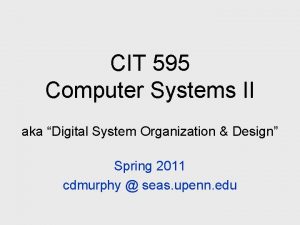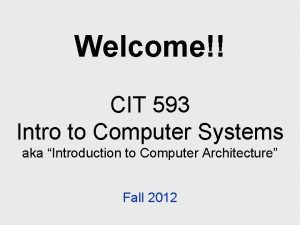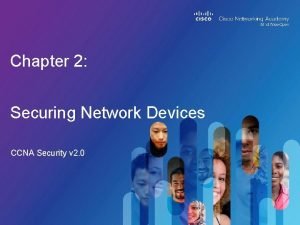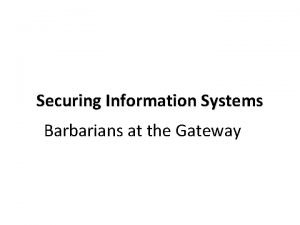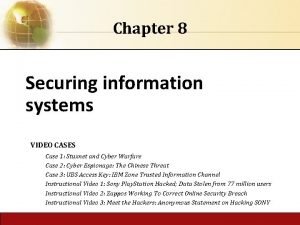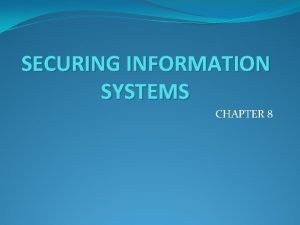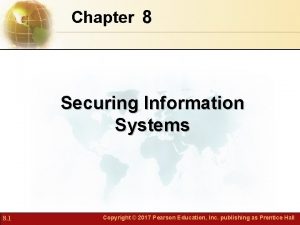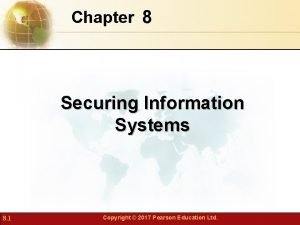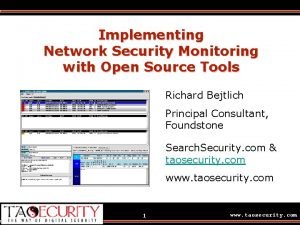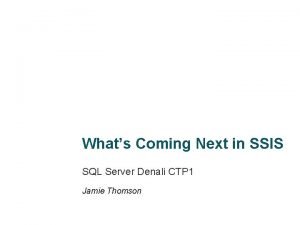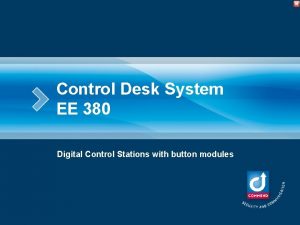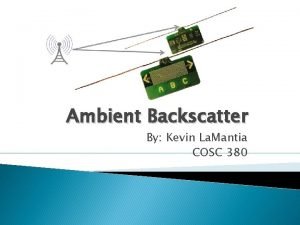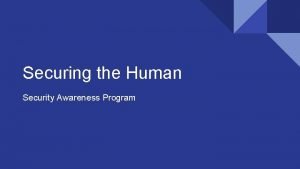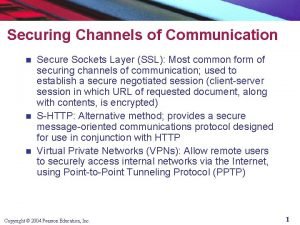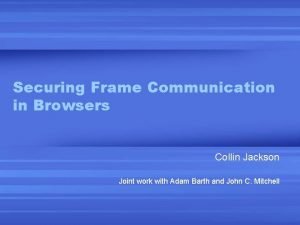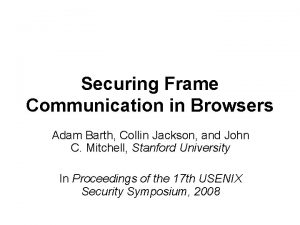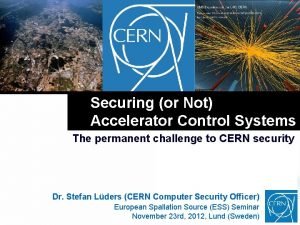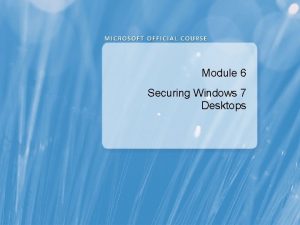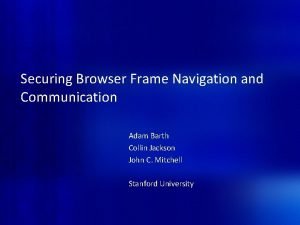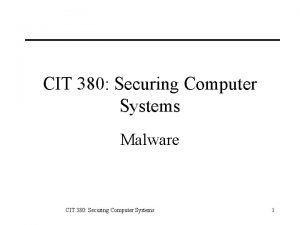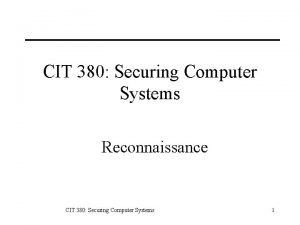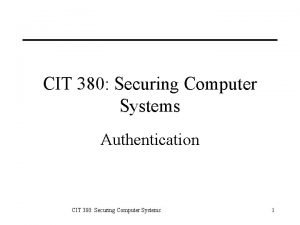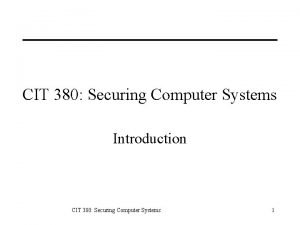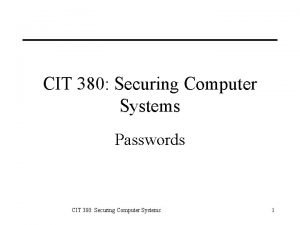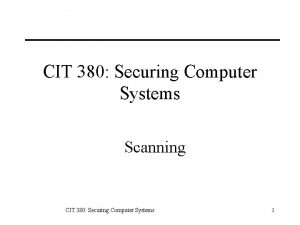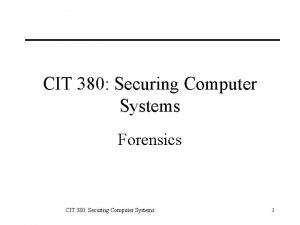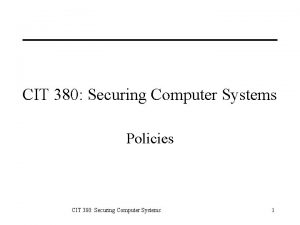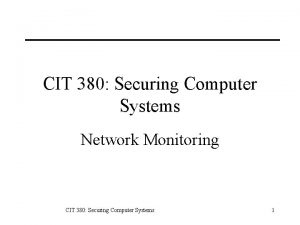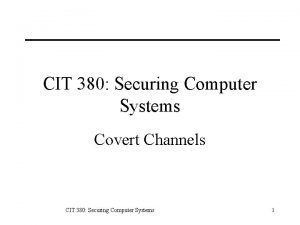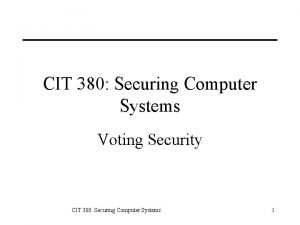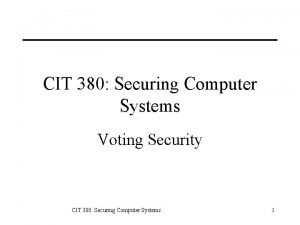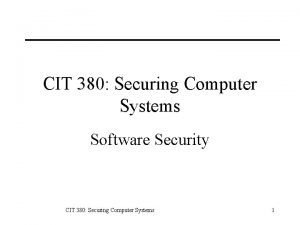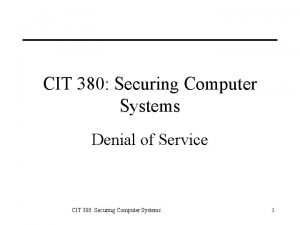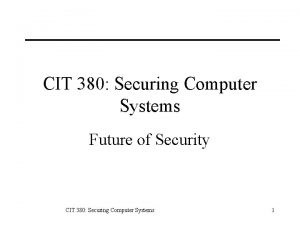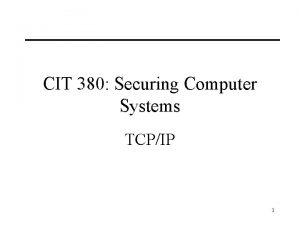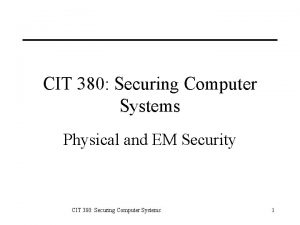CIT 380 Securing Computer Systems Network Monitoring CIT









































- Slides: 41

CIT 380: Securing Computer Systems Network Monitoring CIT 380: Securing Computer Systems 1

Topics 1. 2. 3. 4. 5. 6. 7. 8. Principles Models of Intrusion Detection False Positives Architecture of an IDS Deployment Active Response (IPS) Host-based IDS and IPS IDS Evasion Techniques CIT 380: Securing Computer Systems 2

Principles of Intrusion Detection Characteristics of systems not under attack 1. User, process actions conform to statistically predictable pattern. 2. User, process actions do not include sequences of actions that subvert the security policy. 3. Process actions correspond to a set of specifications describing what the processes are allowed to do. Systems under attack do not meet at least one. CIT 380: Securing Computer Systems 3

Example Goal: insert a back door into a system – Intruder will modify system configuration file or program. – Requires privilege; attacker enters system as an unprivileged user and must acquire privilege. • Nonprivileged user may not normally acquire privilege (violates #1). • Attacker may break in using sequence of commands that violate security policy (violates #2). • Attacker may cause program to act in ways that violate program’s specification (violates #3). CIT 380: Securing Computer Systems 4

Goals of IDS 1. Detect wide variety of intrusions – Previously known and unknown attacks. – Need to adapt to new attacks or changes in behavior. 2. Detect intrusions in timely fashion – May need to be be real-time, especially when system responds to intrusion. • Problem: analyzing commands may impact response time of system. – May suffice to report intrusion occurred a few minutes or hours ago. CIT 380: Securing Computer Systems 5

Goals of IDS 3. Present analysis in easy-to-understand format. – – – Ideally a binary indicator. Usually more complex, allowing analyst to examine suspected attack. User interface critical, especially when monitoring many systems. 4. Be accurate – – Minimize false positives, false negatives. Minimize time spent verifying attacks, looking for them. CIT 380: Securing Computer Systems 6

Deep Packet Inspection • IDS requires, some firewalls do too. • DPI = Analysis of Application Layer data • Protocol Standard Compliance – Is port 53 traffic DNS or a covert shell session? – Is port 80 traffic HTTP or tunneled IM or P 2 P? • Protocol Anomaly Detection – Traffic is valid HTTP. – But suspicious URL contains directory traversal. CIT 380: Securing Computer Systems 7

Models of Intrusion Detection 1. Anomaly detection – What is usual, is known. – What is unusual, is bad. 2. Misuse detection – What is bad is known. – Look for what is bad, hope it doesn’t change. CIT 380: Securing Computer Systems 8

Anomaly Detection Analyzes a set of characteristics of system, and compares their values with expected values; report when computed statistics do not match expected statistics. – Threshold metrics – Sequences of valid actions – Statistical measures CIT 380: Securing Computer Systems 9

Threshold Metrics • Counts number of events that occur – Between m and n events (inclusive) expected – If number falls outside this range, anomalous. • Example – Windows: lock user out after k failed sequential login attempts. Range is (0, k– 1). • k or more failed logins deemed anomalous • Threshold depends on typing skill. CIT 380: Securing Computer Systems 10

Sequences of System Calls • Define normal behavior in terms of sequences of system calls. • Example normal trace: open read write open write close • Doesn’t normally run other programs. • Attack trace: open read write open exec write close CIT 380: Securing Computer Systems 11

Bayesian Filtering Calculate – Probability that a word appears in spam. using training data – Set of spam e-mail. – Set of non-spam e-mail. For new e-mail message – Combine probabilities of each word to calculate probability that message is spam. – If probability > 0. 9, then message is spam. – Tune cutoff to adjust false positive/negative rate. CIT 380: Securing Computer Systems 12

Misuse Detection • Determines whether a sequence of instructions being executed is known to violate the site security policy. – Descriptions of known or potential exploits grouped into rule sets. – IDS matches data against rule sets; on match, potential attack found. • Cannot detect new attacks: – No rules to cover them. CIT 380: Securing Computer Systems 13

Example: snort Network Intrusion Detection System – Sniffs packets off wire. – Checks packets for matches against rule sets. – Logs detected signs of misuse. – Alerts adminstrator when misuse detected. CIT 380: Securing Computer Systems 14

Snort Rules • Rule Header – – Action: pass, log, alert Network Protocol Source Address (Host or Network) + Port Destination Address (Host or Network) + Port • Rule Body – Content: packet ASCII or binary content – TCP/IP flags and options to match – Message to log, indicating nature of misuse detected CIT 380: Securing Computer Systems 15

Snort Rule Example: rule for ssh shell code exploit alert tcp $EXTERNAL_NET any -> $HOME_NET 22 (msg: "EXPLOIT ssh CRC 32 overflow NOOP"; flow: to_server, established; content: "|90 90 90 90 90|"; reference: bugtraq, 2347; reference: cve, CVE-20010144; classtype: shellcode-detect; sid: 1326; rev: 3; ) CIT 380: Securing Computer Systems 16

Comparison and Contrast • Misuse detection: if all policy rules known, easy to construct rulesets to detect violations. – Usual case is that much of policy is unspecified, so rulesets describe attacks, and are not complete. • Anomaly detection: detects unusual events, but these are not necessarily security problems. CIT 380: Securing Computer Systems 17

False Positives • A new test for a disease that is 95% accurate • Assume 1 in 1000 people have disease. • Should everyone get the test? – Sample size: 1000 – Expect 0. 95 + (999 * 0. 05) positives – Ergo, 50 people will be told they have disease – If you test positive, only 2% chance you have it. CIT 380: Securing Computer Systems 18

IDS Architecture An IDS is essentially a sophisticated audit system – Agent gathers data for analysis. – Director analyzes data obtained from the agents according to its internal rules. – Notifier acts on director results. • May simply notify security officer. • May reconfigure agents, director to alter collection, analysis methods. • May activate response mechanism. CIT 380: Securing Computer Systems 19

Agents Obtain information and sends to director. Preprocessing – Simplifying and reformatting of data. Push vs Pull – Agents may push data to Director, or – Director may pull data from Agents. CIT 380: Securing Computer Systems 20

Host-Based Agents 1. Obtain information from logs – – – May use many logs as sources. May be security-related or not. May use virtual logs if agent is part of the kernel. 2. Agent generates its information – – Analyzes state of system. Treats results of analysis as log data. CIT 380: Securing Computer Systems 21

Network-Based Agents • Sniff traffic from network. – Use hubs, SPAN ports, or taps to see traffic. – Need agents on all switches to see entire network. • Agent needs same view of traffic as destination – TTL tricks, fragmentation may obscure this. • End-to-end encryption defeats content monitoring – Not traffic analysis, though. CIT 380: Securing Computer Systems 22

Aggregation of Information Agents produce information at multiple layers of abstraction. – Application-monitoring agents provide one view of an event. – System-monitoring agents provide a different view of an event. – Network-monitoring agents provide yet another view (involving many packets) of an event. CIT 380: Securing Computer Systems 23

Director • Reduces information from agents – Eliminates unnecessary, redundant records. • Analyzes information to detect attacks – Analysis engine can use any of the modelling techniques. • Usually run on separate system – Does not impact performance of monitored systems. – Rules, profiles not available to ordinary users. CIT 380: Securing Computer Systems 24

Example • Jane logs in to perform system maintenance during the day. • She logs in at night to write reports. • One night she begins recompiling the kernel. • Agent #1 reports logins and logouts. • Agent #2 reports commands executed. – Neither agent spots discrepancy. – Director correlates log, spots it at once. CIT 380: Securing Computer Systems 25

Adaptive Directors • Modify profiles, rulesets to adapt their analysis to changes in system – Usually use machine learning or planning to determine how to do this. • Example: use neural nets to analyze logs – Network adapted to users’ behavior over time. – Used learning techniques to improve classification of events as anomalous. • Reduced number of false alarms. CIT 380: Securing Computer Systems 26

Notifier • Accepts information from director • Takes appropriate action – Notify system security officer – Respond to attack • Often GUIs – Use visualization to convey information. CIT 380: Securing Computer Systems 27

Example Architecture: snort CIT 380: Securing Computer Systems 28

IDS Deployment IDS deployment should reflect your threat model. Major classes of attackers: 1. External attackers intruding from Internet. 2. Internal attackers intruding from your LANs. Where should you place IDS systems? 1. 2. 3. 4. Perimeter (outside firewall) DMZ Intranet Wireless CIT 380: Securing Computer Systems 29

IDS Deployment CIT 380: Securing Computer Systems 30

Sguil NSM Console CIT 380: Securing Computer Systems 31

Intrusion Prevention Systems • What else can you do with IDS alerts? – Identify attack before it completes. – Prevent it from completing. • How to prevent attacks? – Directly: IPS drops attack packets. – Indirectly: IPS modifies firewall rules. • Is IPS a good idea? – How do you deal with false positives? CIT 380: Securing Computer Systems 32

IPS Deployment Types Inline IPS Non-Inline Intranet IPS Intranet CIT 380: Securing Computer Systems 33

Active Responses by Network Layer • Data Link: Shut down a switch port. Only useful for local intrusions. Rate limit switch ports. • Network: Block a particular IP address. – Inline: can perform blocking itself. – Non-inline: send request to firewall. • Transport: Send TCP RST or ICMP messages to sender and target to tear down TCP sessions. • Application: Inline IPS can modify application data to be harmless: /bin/sh -> /ben/sh CIT 380: Securing Computer Systems 34

Host IDS and IPS • Anti-virus and anti-spyware – AVG anti-virus, Spy. Bot S&D • Log monitors – swatch, logwatch • Integrity checkers – tripwire, osiris, samhain – Monitor file checksums, etc. • Application shims – mod_security CIT 380: Securing Computer Systems 35

Evading IDS and IPS Alter appearance to prevent sig match – URL encode parameters to avoid match. – Use ‘ or 783>412 -- for SQL injection. Alter context – Change TTL so IDS sees different packets than target hosts receives. – Fragment packets so that IDS and target host reassemble the packets differently. CIT 380: Securing Computer Systems 36

Fragment Evasion Techniques Use fragments – Older IDS cannot handle reassembly. Flood of fragments – Do. S via heavy use of CPU/RAM on IDS. Tiny fragment – Break attack into multiple fragments, none of which match signature. – ex: frag 1: “cat /etc”, frag 2: “/shadow” Overlapping fragments – Offset of later fragments overwrites earlier fragments. – ex: frag 1: “cat /etc/fred”, frag 2: offset=10, “shadow” – Different OSes deal differently with overlapping. CIT 380: Securing Computer Systems 37

Web Evasion Techniques URL encoding – GET /%63%67%69%2 d%62%69%6 e/bad. cgi /. / directory insertion – GET /. /cgi-bin/. /bad. cgi Long directory insertion – GET /junklongdirectorypathstuffhereuseless/. . /cgi-bin/bad. cgi – IDS may only read first part of URL for speed. Tab separation – GET<tab>/cgi-bin/bad. cgi – Tabs usually work on servers, but may not be in sig. Case sensitivity – GET /CGI-BIN/bad. cgi – Windows filenames are case insensitive, but signature may not be. CIT 380: Securing Computer Systems 38

Countering Evasion • Keep IDS/IPS signatures up to date. – On daily or weekly basis. • Use both host and network IDS/IPS. – Host-based harder to evade as runs on host. – Fragment attacks can’t evade host IDS. – Network IDS still useful as overall monitor. • Like any alarm, IDS/IPS has – False positives – False negatives CIT 380: Securing Computer Systems 39

Key Points • Models of IDS: – Anomaly detection: unexpected events. – Misuse detection: violations of policy. • IDS Architecture: – Agents. – Director. – Notifiers. • Types of IDS – Host: agent on host checks files, procs to detect attacks. – Network: sniffs and analyzes packets to detect intrusions. • IDS/IPS Evasion – Alter appearance to avoid signature match. – Alter context to so IDS interprets differently than host. CIT 380: Securing Computer Systems 40

References 1. 2. 3. 4. 5. 6. 7. 8. 9. 10. 11. Richard Bejtlich, The Tao of Network Security Monitoring, Addison-Wesley, 2004. Matt Bishop, Computer Security: Art and Science, Addison-Wesley, 2003. Brian Caswell, et. al. , Snort 2. 0 Intrusion Detection, Snygress, 2003. William Cheswick, Steven Bellovin, and Avriel Rubin, Firewalls and Internet Security, 2 nd edition, 2003. The Honeynet Project, Know Your Enemy, 2 nd edition, Addison-Wesley, 2004. Richard A. Kemmerer and Giovanni Vigna, “Intrusion Detection: A Brief History and Overview, ” IEEE Security & Privacy, v 1 n 1, Apr 2002, pp 27 -30. Steven Northcutt and Julie Novak, Network Intrusion Detection, 3 rd edition, New Riders, 2002. Michael Rash et. al. , Intrusion Prevention and Active Response, Syngress, 2005. Rafiq Rehman, Intrusion Detection Systems with Snort: Advanced IDS Techniques Using Snort, Apache, My. SQL, PHP, and ACID, Prentice Hall, 2003. Ed Skoudis, Counter Hack Reloaded 2/e, Prentice Hall, 2006. Ed Skoudis and Lenny Zeltser, Malware: Fighting Malicious Code, Prentice Hall, 2003. CIT 380: Securing Computer Systems 41
 Cit 595 upenn
Cit 595 upenn Mcit 593
Mcit 593 Securing network devices
Securing network devices Securing information system
Securing information system Securing information systems
Securing information systems Securing information systems
Securing information systems Chapter 8 securing information systems
Chapter 8 securing information systems An information systems examines a firm's overall security
An information systems examines a firm's overall security Chapter 8 securing information systems
Chapter 8 securing information systems Chapter 8 securing information systems
Chapter 8 securing information systems Open systems nsm network security monitoring
Open systems nsm network security monitoring Ece 526
Ece 526 Network topologies
Network topologies Ssis 380
Ssis 380 Ee 380
Ee 380 690-380
690-380 710 a yuvarlanan en küçük sayı
710 a yuvarlanan en küçük sayı The lobstah buoy
The lobstah buoy 380 gelir tahakkukları
380 gelir tahakkukları Ua 380
Ua 380 Fluorocarbon gel 880
Fluorocarbon gel 880 18 gelecek aylara ait giderler ve gelir tahakkukları
18 gelecek aylara ait giderler ve gelir tahakkukları Ee 380
Ee 380 Cit upenn
Cit upenn Dönem ayirici hesaplar 180 181 280 281 380 381
Dönem ayirici hesaplar 180 181 280 281 380 381 380 lexington ave
380 lexington ave 507-802-380
507-802-380 Diagrama dispersão
Diagrama dispersão Sin values
Sin values Kevin 380
Kevin 380 Cit 592 mathematical foundations of computer science
Cit 592 mathematical foundations of computer science Securing the human
Securing the human The most common form of securing channels is through
The most common form of securing channels is through Securing frame communication in browsers
Securing frame communication in browsers Securing frame communication in browsers
Securing frame communication in browsers Chapter 8 securing the republic summary
Chapter 8 securing the republic summary Securing windows 7
Securing windows 7 Securing
Securing Securing windows 7
Securing windows 7 The capes used for shampooing wet hair sculpting
The capes used for shampooing wet hair sculpting Securing the northwest territory
Securing the northwest territory Securing frame communication in browsers
Securing frame communication in browsers
